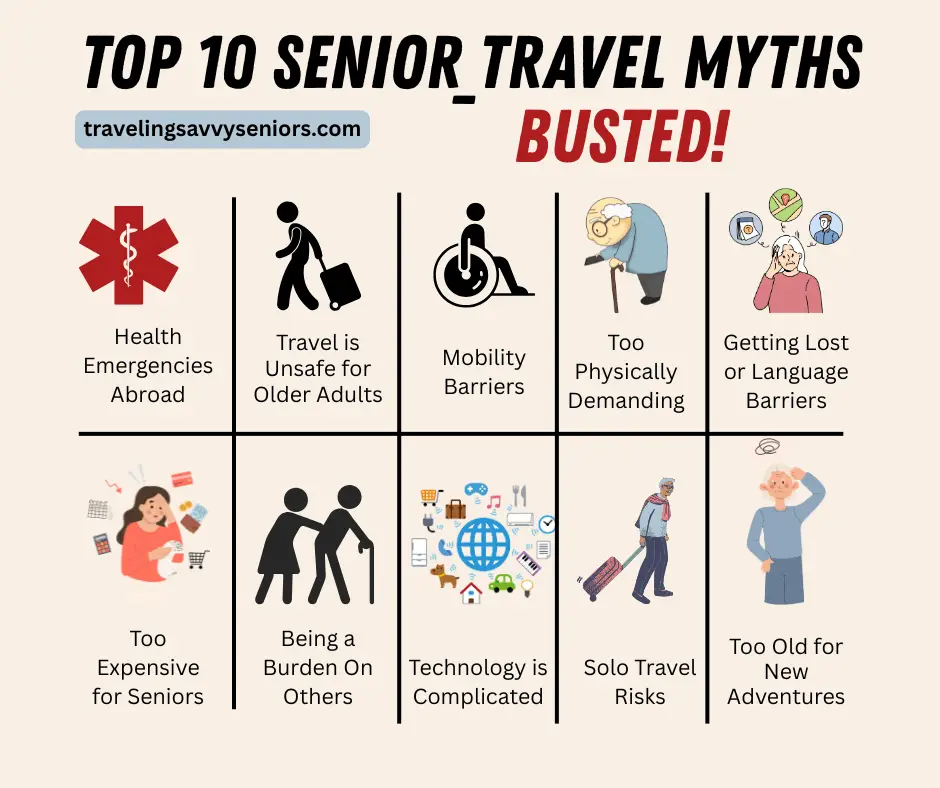Collect moments, not things
Traveling is fun and exciting, no matter your age. But for seniors with mobility issues, it can sometimes feel tricky. The good news? It doesn’t have to be!
Here’s the deal: with the right tips and some smart planning, you can still enjoy amazing trips. This guide shares the best travel tips for seniors with mobility issues to help you travel safely, comfortably, and happily.
10 Travel Tips For Seniors With Mobility Issues
1. Plan Ahead and Carefully for an Easy Trip
Now: the first step to a great trip is making a good plan.
Before you pack your bags, learn as much as you can about the place you’re visiting. Does your hotel have ramps, elevators, and wide doors? If you’re using a wheelchair or walker, these things are super important. It’s always best to call the hotel to double-check because websites don’t always tell the whole story.
Also, think about how you’ll get around. Many big cities have buses and trains that are easy for people with mobility issues to use. Some places even offer special transportation services just for seniors.
If you’re flying, ask the airline for help. They can provide wheelchairs, help you board the plane early, and even carry your luggage. Don’t wait until the last minute—tell them ahead of time.
Finally, choose a destination that’s easy to explore. Look for places with smooth sidewalks, ramps, and nearby medical centers, just in case. The more prepared you are, the more fun you’ll have.

2. Always Share, Tell People What You Need
You might be wondering: how do I make sure people know what I need?
It’s simple: tell them! Airlines, hotels, and tour guides can only help if they know what you need. Let them know about your mobility requirements when you book.
For example, airlines can:
- Reserve seats with extra legroom
- Provide wheelchairs at the airport
- Help you get on and off the plane
Most airports have workers who can assist you, but you have to ask before you arrive. The same goes for hotels—tell them if you need a room with a walk-in shower or a room on the ground floor.
When joining tours, make sure the routes are easy to walk or roll through. Ask if transportation during the tour can fit wheelchairs or walkers. When you clearly share your needs, your trip becomes easier and more enjoyable.
3. Pack Only What You Need, Smart and Light
But here’s the kicker: packing the right things makes your trip stress-free.
Start with your medicines. Always pack them in your carry-on bag, so you have them with you at all times. Bring an extra supply in case of delays. Also, write down the names of your medicines in case you need to buy more while traveling.
Wear comfortable clothes and supportive shoes. If you’re flying, consider compression socks. These socks help your blood circulate, which is especially important on long flights.
Lastly, choose luggage that’s easy to carry. A suitcase with wheels and a lightweight bag you can wear across your body are great options. The lighter your luggage, the easier your trip will be.

4. Pick the Easy and Right Places to Visit
This is crazy: some of the most beautiful places in the world are also easy to explore.
Cruises are an excellent choice for seniors with mobility issues. Why? Because you can visit multiple places without having to pack and unpack all the time. Cruise ships often have wide hallways, elevators, and activities that don’t require a lot of walking.
Some cities are also known for being easy to get around. For example, Barcelona has flat streets and accessible public transport. Sydney’s beaches have wheelchair-friendly paths. Research destinations where you won’t have to worry about stairs or rough terrain.
When planning what to do, take it slow. Don’t try to see everything in one day. Pick a few interesting activities and leave plenty of time for rest. This way, you’ll have energy to enjoy every moment.
5. Get Travel Insurance for Safety
Want to know the best part? Travel insurance gives you peace of mind.
Travel insurance is like a safety net. If you get sick or your plans change, insurance helps you avoid big problems. For seniors with mobility issues, this is especially important.
When buying insurance, make sure it covers:
- Medical emergencies
- Lost or damaged mobility equipment
- Trip cancellations
Some insurance plans also cover accidents that might happen while traveling. Double-check that the policy includes pre-existing conditions if you have any.
With good insurance, you can relax and focus on enjoying your trip. If something unexpected happens, you’ll be covered.
6. Use Mobility Aids, Tools and Services
Now: there’s no shame in using mobility aids—they’re there to help you.
If you already use a cane, walker, or wheelchair at home, bring it with you. Airlines and buses will usually carry these items for free. Just let them know beforehand.
Sometimes, renting mobility aids at your destination is easier. For example, some places offer scooters or wheelchairs for tourists. Booking these early ensures they’ll be ready when you arrive.
Also, ask about transportation services. Some hotels and cities offer shuttle buses with ramps and wide doors. These services make exploring much easier.

7. Take It Slow and Rest Often—No Rush!
What’s the bottom line? Traveling should be fun, not exhausting.
Don’t try to pack too many activities into one day. Plan for breaks between activities, especially if walking tires you out. A slow and steady pace lets you enjoy your trip without feeling worn out.
Listen to your body. If you’re tired, take a break. Grab a coffee at a local café, sit at a park, or return to your hotel for a nap. Remember, the goal isn’t to see everything—it’s to enjoy the experience.

8. Use Apps to Make Travel Easier
It gets better: technology makes traveling much easier today.
Smartphones are more than just phones—they’re your best travel buddy. Download apps like:
- Wheelmap: Helps you find wheelchair-accessible places.
- AccessNow: Shows accessible restaurants, hotels, and tourist spots.
- Google Maps: Offers directions for wheelchair-accessible routes.
If you’re visiting a country where you don’t speak the language, translation apps can help you communicate your needs. Technology keeps you informed and confident throughout your journey.
9. Know Your Rights When You Travel
But here’s the kicker: you have rights that protect you when traveling.
For example, in the United States, the Air Carrier Access Act says airlines must help passengers with mobility issues. They must provide wheelchairs, help you board, and give you accessible seating at no extra cost.
Learn about the rules in other countries too. Knowing your rights means you can speak up if you’re not treated fairly. It’s important to remember that travel companies are required to help make your trip comfortable.
10. Get Help from Travel Experts
Here’s the deal: you don’t have to plan your trip alone.
Some travel companies specialize in accessible travel for seniors. These companies know exactly what you need and how to make your trip easy and enjoyable.
For example, some agencies offer trips designed specifically for people with mobility issues. They handle all the details—like finding accessible hotels and transportation—so you can relax.
Working with these professionals means fewer surprises and more time for fun. You’ll travel with confidence, knowing everything is set up for you.
So, the best travel tips for seniors with mobility issues are all about smart planning, clear communication, and using the right tools.
Pick easy-to-navigate places, pack smart, pace yourself, and know your rights. Don’t forget travel insurance—it’s a must! If you’re unsure about planning, let us know. Mary Johnson is your go-to Travel Advisor. She specializes in crafting personalized itineraries, offering expert guidance on destinations, accommodations, and unique experiences tailored to your needs. With a commitment to exceptional service and attention to detail, she ensures every journey is seamless, enjoyable, and enriching.
The truth is, mobility issues don’t have to limit your adventures. With these tips, the world is still wide open for you. One well-planned trip at a time, you’ll keep exploring, discovering, and enjoying life’s best moments.
Turning Dreams Into Destinations





